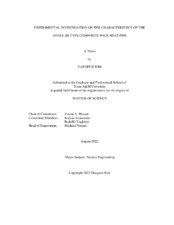| dc.description.abstract | An experimental investigation was conducted on the hydraulic characteristics of annular type wick structures for heat pipes. An experimental facility that can measure porosity, permeability and effective pore radius of the wick structures in a vacuum condition is established. Nine different multi-layered (6 layers in total) composite screen meshes are characterized. Based on the measurement results, a wick structure composed of one layer of 100×100 mesh, three layers of 400×400 mesh, and two layers of 60×60 mesh is determined to have the highest permeability to effective pore radius ratio and was selected as a targeted sample. The wick-to-wall gap effect on the hydraulic characteristics of annular type wick structure is also investigated by measuring the permeability and effective pore radius of the sample wick structure with varying gap widths. The result shows that the permeability increases as the gap increases from 0 mm to 1.2 mm. After a peak at 1.2 mm, the permeability decreases as the gap increases and converges to the value of the case measured without a wall structure. The effective pore radius becomes smaller as the gap increases, making a peak at a gap size of 1.2 mm. This result implies that there is an optimal point in gap size which is determined to be 1.2 mm for the selected composite mesh structure. To describe and model the advantage of this gap, the rising of a wetting liquid in the gap between a vertical solid plate and a mesh (with a small angle between them) was experimentally measured and analyzed. An additional experiment was performed to investigate the effect of curvature on the capillary rise using tubes and meshes of varying radii. Resultantly, we confirmed that the linear combination of the contact angles of the solid plate and mesh could be applied to calculate the rising height from the Laplace–Young equation. Furthermore, the effect of curvature on the rising height of the liquid was negligible. We observed that a gap distance of 1.27 mm provided the largest permeability over the effective pore radius value for a heat pipe with ethanol, which in turn resulted in the highest capillary limitation. Finally, an annular wick-type heat pipe is constructed and tested. The capillary limitation of the heat pipe showed good agreement with the suggested correlation. Additional research on measuring temperature distribution and visualizing the inside of the heat pipe is performed to understand the heat pipe behavior. A fiber optic sensor was used to measure the temperature distribution of the heat pipe during the transient and steady-state. Compared to the previously used sensors, thermocouples, for example, the fiber optic sensor provides more precise and detailed temperature data. A complete clear glass tube heat pipe was constructed using a transparent glass heater, allowing a fully visualized heat pipe experiment to observe the phenomena inside the heat pipe. | |


